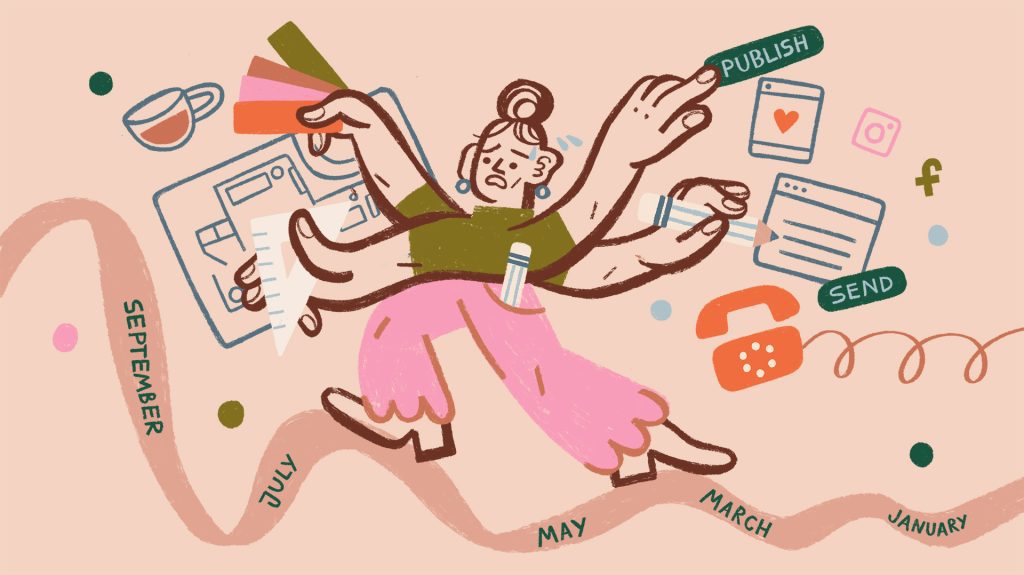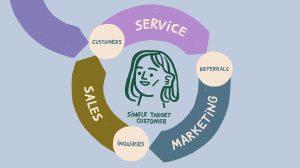Written by Daniela Furtado
If you’re struggling to get work and do the work, it’s not because you’re lazy. Despite what you may tell yourself. Break the feast-to-famine cycle for good with these five-pointers.

Every January, this happens. Principles tell me they want to take their marketing seriously. “This year, I don’t want to just ‘make it’ with referrals,” they say.
Some sign on with us and others ask me to check back in a few months. By spring, many of them have lost steam. They said they would add recent projects to their website and post weekly on social media. But it’s April and they can’t remember the last time they logged in to their accounts, let alone scheduled an update.
According to a Forbes survey, 87% of people abandon their New Year’s Resolutions by April. If this is you, you’re not alone. However, despite what you may tell yourself, it’s not because you’re lazy or procrastinating.
I believe this happens when you don’t have the systems to work on the business and in it. It’s like trying to eat healthy in a food desert. Your environment doesn’t make it possible, let alone easy, for you to make a change.
The Feast to Famine Cycle
In business, it’s called the “feast-to-famine” cycle. You spend months chasing new work. But once it’s secured, you’re so busy working that lead generation falls to the back burner and you don’t have anything else lined up for when the project ends. Stressed and anxious, you repeat the pattern all over again. Since you keep selling from a place of scarcity (hence “famine”), you’re more likely to take on work you don’t really want or underprice just to make the sale – never leaving enough money left over to invest in your growth.
It’s a pattern service-based business owners get trapped in. At Findable, we’ve spent years wrestling to understand and help pull firms out of the feast-to-famine cycle, including our own. Why does it happen? And how can you avoid it?
I can boil it down to five points.
Problem #1. You only market when it’s quiet.
Marketing doesn’t work when you’re doing the bare minimum or being inconsistent. It thrives off compounded effort. It’s a lot like investing in the stock market. If you only invest $20 a year or if you pull out every six months, it doesn’t reach its full potential.
Instead, prioritize marketing year-round. Even when you’re busy.
Make it easy and enjoyable for yourself, yet still impactful for the company. Do less but show up often starting with one hour a day. Hire help, even if it’s just a part-time virtual assistant. Make it an essential part of your business and day-to-day operations.
Problem #2. You’re stuck in the weeds of client work.
You can’t dedicate as much time as you’d like on sales because you have to help your team get the work done. Usually, this is because you’re the most senior person in the company.
If you want to get out of the cycle, hire more experienced team members and build processes for your team to solve problems without you.
Zoe Feldman is a designer who’s really figured this out. In a Business of Home podcast interview, she shares how she built her operations to create space for designing and sales marketing, while also avoiding getting caught up in the details.
Problem #3. You don’t have a proper business development strategy.
Say you hired a project manager tomorrow, and she reduced your workload by 40%. What would you do? If you had the time to focus on business development, would you know how?
Start with positioning. What are you an expert in? Who is willing to pay a premium for it? Why? And where are they? Then work backwards to create a marketing strategy, both online and offline.
Problem #4. You didn’t factor marketing into your finances.
Whether you’re marketing in-house or out, someone has to pay for it. If you’re not budgeting for it, it’s eating up your profit margins.
Once you have a strategy in place, research how much it will cost to execute it. How many hours will you dedicate a month between you and your team? Multiply this by your hourly rate. Will you hire subcontractors? Purchase software? What about ad spend or events?
Whatever the final dollar amount is, include it in your pricing and start putting it aside with every deal you close. Something I wish I had done earlier was to make sure the projects I signed on today paid for the marketing I did tomorrow.
Problem #5. You don’t think you’re worth promoting.
I almost didn’t add this, but I remembered what James Clear said after talking to my new friend Ula. “The key to building lasting habits is focusing on creating a new identity first.” If you think sales, marketing and self-promotion are icky, then no amount of systems will get you out there.
Solving these problems will require you to rethink and restructure many aspects of your business. You’re building a foundation and setting it up to run and grow without you in the epicentre. This takes time and patience. Not months, but years. It can be uncomfortable but as long as you’re committed to it, the feast-to-famine cycles will get shorter.
And frankly, you can always choose to stop growing. At some point, you’ll find a sweet spot. With enough trial and error, you’ll learn how much business development is enough for you before it feels like you’re just feeding a beast.
How to Work with Us
We help design-build firms increase website traffic by 5 times and sales inquiries by 3 times. Hire us to train you on our program, or do it all for you.
Check out the five questions to ask yourself before hiring an agency. If you think we’d make a good team, contact us today!
Daniela Furtado
Daniela Furtado is a consultant, writer and speaker on how to make businesses easy to find online. She is the founder and CEO of Findable Digital Marketing. Off the clock, she enjoys cooking, dancing, and drawing. She is based in Toronto, Canada.
 Why You’re Not Getting High-End Clients
Why You’re Not Getting High-End Clients 15 Tips on Digital Marketing for Designers and Architects
15 Tips on Digital Marketing for Designers and Architects Is Your Interior Design Portfolio Traffic-less?
Is Your Interior Design Portfolio Traffic-less?

